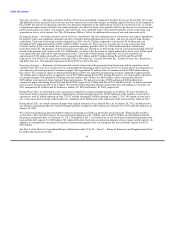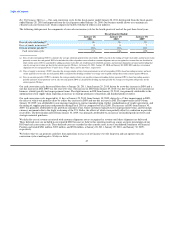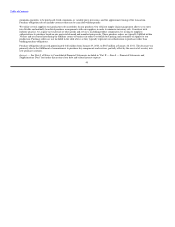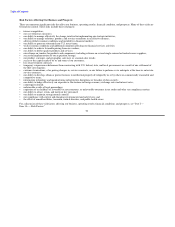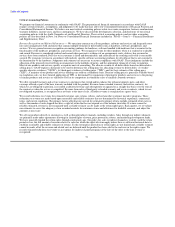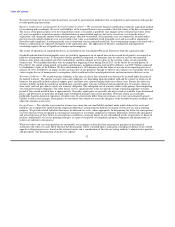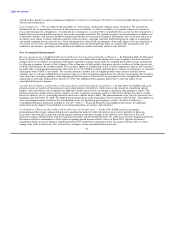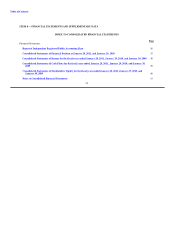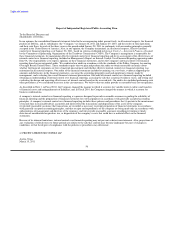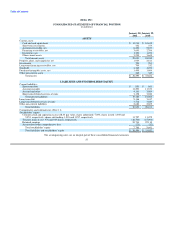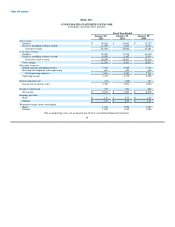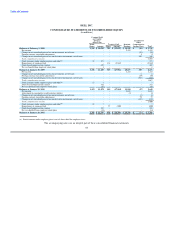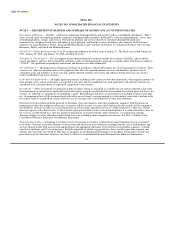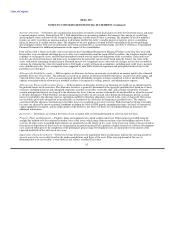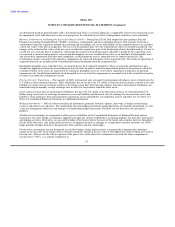Dell 2010 Annual Report Download - page 57
Download and view the complete annual report
Please find page 57 of the 2010 Dell annual report below. You can navigate through the pages in the report by either clicking on the pages listed below, or by using the keyword search tool below to find specific information within the annual report.
Table of Contents
related to these positions requires management judgment as well as use of estimates. We believe we have provided adequate reserves for
all uncertain tax positions.
Loss Contingencies — We are subject to the possibility of various losses arising in the ordinary course of business. We consider the
likelihood of loss or impairment of an asset or the incurrence of a liability, as well as our ability to reasonably estimate the amount of
loss, in determining loss contingencies. An estimated loss contingency is accrued when it is probable that an asset has been impaired or a
liability has been incurred and the amount of loss can be reasonably estimated. We regularly evaluate current information available to us
to determine whether such accruals should be adjusted and whether new accruals are required. Third parties have in the past and may in
the future assert claims or initiate litigation related to exclusive patent, copyright, and other intellectual property rights to technologies
and related standards that are relevant to us. If any infringement or other intellectual property claim made against us by any third party is
successful, or if we fail to develop non-infringing technology or license the proprietary rights on commercially reasonable terms and
conditions, our business, operating results, and financial condition could be materially and adversely affected.
New Accounting Pronouncements
Revenue Arrangements with Multiple Elements and Revenue Arrangements with Software Elements — In September 2009, the Emerging
Issues Task Force of the FASB reached a consensus on two issues which affects the timing of revenue recognition. The first consensus
changes the level of evidence of standalone selling price required to separate deliverables in a multiple deliverable revenue arrangement
by allowing a company to make its best estimate of the selling price of deliverables when more objective evidence of selling price is not
available and eliminates the residual method. The consensus applies to multiple deliverable revenue arrangements that are not accounted
for under other accounting pronouncements and retains the use of VSOE if available and third-party evidence of selling price or estimated
selling price when VSOE is unavailable. The second consensus excludes sales of tangible products that contain essential software
elements, that is, software enabled devices, from the scope of revenue recognition requirements for software arrangements. We elected to
early adopt this accounting guidance at the beginning of the first quarter of Fiscal 2011 on a prospective basis for applicable transactions
originating or materially modified after January 29, 2010. The adoption of this guidance did not have a material impact to our
consolidated financial statements.
Variable Interest Entities and Transfers of Financial Assets and Extinguishments of Liabilities — In June 2009, the FASB issued a new
pronouncement on transfers of financial assets and extinguishments of liabilities, which removes the concept of a qualifying special
purpose entity and removes the exception from applying variable interest entity accounting to qualifying special-purpose entities. The
pronouncement on variable interest entities requires an entity to perform an ongoing analysis to determine whether the entity's variable
interest or interests give it a controlling financial interest in a variable interest entity. The pronouncements were effective for fiscal years
beginning after November 15, 2009. We adopted the pronouncements at the beginning of the first quarter of Fiscal 2011. The adoption of
these two pronouncements resulted in the consolidation of our two qualifying special purpose entities. See Note 4 of Notes to
Consolidated Financial Statements included in "Part II — Item 8 — Financial Statements and Supplementary Data" for additional
information on the impact of consolidation to our financial position, net income, and cash flows.
Credit Quality of Financing Receivables and the Allowance for Credit Losses — In July 2010, FASB issued an accounting
pronouncement that requires enhanced disclosures regarding the nature of credit risk inherent in an entity's portfolio of financing
receivables, how that risk is analyzed, and the changes and reasons for those changes in the allowance for credit losses. The new
disclosures require information for both the financing receivables and the related allowance for credit losses at more disaggregated levels.
Disclosures related to information as of the end of a reporting period became effective for us in Fiscal 2011. Specific disclosures
regarding activities that occur during a reporting period will be required for us beginning in the first quarter of Fiscal 2012. As these
changes only relate to disclosures, they will not have an impact on our consolidated financial results.
53





